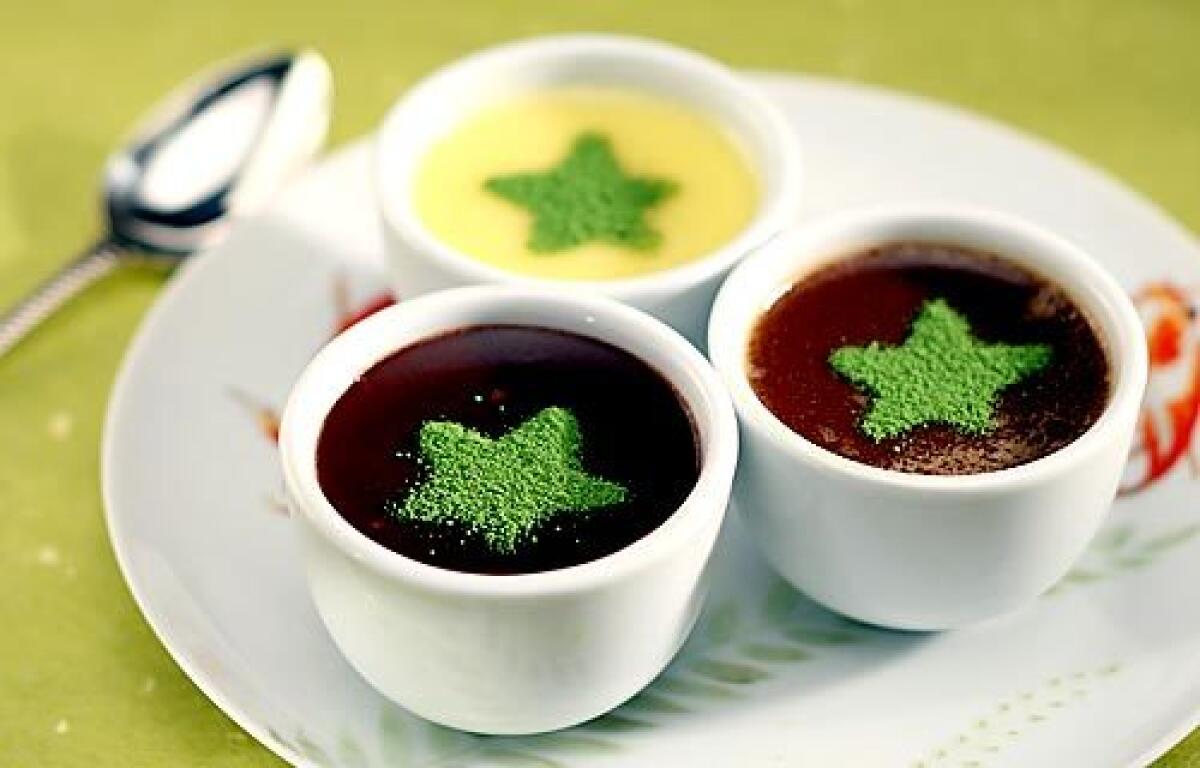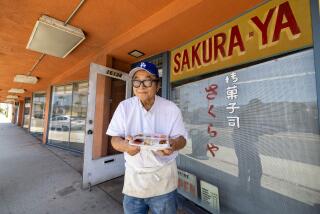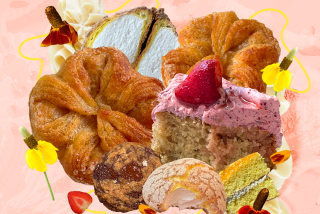Matchaâs green tea powder and chocolate: a bitter-sweet combo

Reporting from Paris â For chocolate, a matcha made in heaven.
At a glance, the cross-cultural dessert pairing of chocolate and matcha, the prized Japanese green tea powder, may not seem the sort of combination to elicit uncontrollable cravings. Among the many terms used to evoke matchaâs elusively complex character -- grassy, spinachy, watercress-like, seaweedy, earthy, floral, herbaceous, aquatic, bitter -- barely a single one screams dessert.
But still, itâs quite the rage in Paris and Tokyo, where the only really big question is: Which chocolate makes the best matcha match?
Three master chocolatiers with designer pastry shops in Paris and Tokyo have three different preferences. Parisian pâtissier Sadaharu Aoki defied chocolate fashion, playing the sweetness of white chocolate against the bitterness of matcha, when he introduced his truffes ivoires au mâcha -- white chocolate green tea truffles -- 10 years ago.
Jean-Paul HĂŠvin went the opposite direction, partnering the bitterness of dark chocolate with matcha in his dacquoise layered with dark chocolate nibs, green tea Bavarian cream, crisp praline pastry flakesand Morello cherry gelĂŠe.
And Pierre HermĂŠ prefers milk chocolate as a less imposing, more compatible option than semi- or bittersweet chocolate for his chocolate green tea truffles and chocolate green tea ganache.
Matcha is made from a premium spring-picked Japanese green tea that is covered with reed screens and rice straw before it is harvested. Blocking direct sunlight slows the rate of photosynthesis in the tea leaves and results in a higher amount of L-theanine. That powerful amino acid is responsible for matchaâs delicate sweetness, full-bodied flavor and umami taste.
The leaves are first steamed to prevent oxidation and preserve their flavor, aroma, color and antioxidants. Then they are cooled, dried and finely ground to a powder in stone mills. As a general rule, the greener that powder, the better the tea made from it.
Edible green tea
Pulverizing green tea to a powder allows matcha drinkers to ingest it whole. Matcha powder is not brewed through steeping and straining, as loose teas are. It is traditionally prepared by whisking the powder into a small bowl of hot but not boiling water with a small bamboo implement known as a chasen to form creamy foam.
The other advantage of green tea in powdered form is that itâs edible and palatable. Matcha is a common, popular and vividly colored addition to Japanese candies, cookies, pastries, ice creams and cakes, including the cherished sticky rice cakes called mochi.
The pairing of chocolate and matcha is certainly not restricted to Paris and Tokyo.
As a flight attendant for All Nippon Airways, Kristy Choo discovered matcha cakes and matcha chocolate candies while foraging for supermarket snacks during her Tokyo stopovers. These were some of the foreign food adventures that inspired the Singaporean to enroll at the California Culinary Academy in San Francisco and eventually open Jin Patisserie, a pastry, chocolate and tea boutique on Abbot Kinney Boulevard in Venice in 2002.
For Jin, Choo blended semisweet and white chocolate in chocolate matcha truffles. From her âresearchâ in the aisles of Japanese supermarkets sheâd learned that white chocolate does not mask the flavor of matcha. But if she thought the dose of white chocolate would sweeten the response of a clientele unaccustomed to the bitterness of matcha she neednât have bothered. Many of her clients were already green-tea-drinking Japanophiles hip to matchaâs taste profile.
Others have developed and sustained a taste for matcha desserts via green tea frozen yogurts (Pinkberry, Red Mango, Yogen Fruz, et al.) and the green tea mochi ice creams like those made by L.A.âs Mikawaya for Trader Joeâs and other stores, including its own in Little Tokyo. If itâs cold, dairy and green, Southern Californians canât seem to get enough of it.
In fact, Carol Negiar, who introduced Parisians to the pleasures and possibilities of green tea and now supplies French pastry chefs with the high-quality matcha powder she imports (as well as the matcha almond paste she prepares from it), is a Palos Verdes Estates native with an MBA from USC. Enchanted by the taste of matcha while attending her first Japanese tea ceremony in 1980, 10 years later she quit her job at a bank in Paris and opened Chajin, a Japanese salon de thĂŠ vert on Parisâ Right Bank.
Chocolate quandary
But back to the main question: Which chocolate to match with matcha? The answer may surprise some chocolate lovers. Negiar, though a certified green tea and chocolate snob, confesses to liking NestlĂŠâs white chocolate matcha KitKats. L.A.-based candy blogger Cybele May (www.candyblog.net) is no fan of white chocolate -- âIt can be SO sweet!â -- but finds worth in Meijiâs white chocolate matcha bar -- âI wouldnât eat a lot of it, but it is nice.â
The combination isnât found just at the candy counter. The French Laundryâs pavĂŠ de chocolat blanc au thĂŠ vert, a bar of white chocolate layered with matcha mousse and a passionfruit gelĂŠe, is better than nice. Two years ago chef de cuisine Corey Lee returned from a trip to Japan with some fine matcha and wanted to put it to use. He and Claire Clark, then the renowned restaurantâs pastry chef, explored various flavor combinations and chose white chocolate despite its bad reputation.
The white chocolate lent a creamier, more luxurious mouth feel that offset the bitterness and tannin of the green tea. And although white chocolate lacks the cocoa intensity that could overwhelm the matcha nuances, Lee insists it does have a discernible flavor. âWhite chocolate has a significant place in the kitchen,â he says.
On the other hand, why not decide for yourself? First, sprinkle tiny quantities of matcha powder over pieces of white, milk and dark chocolate. Next, brew some matcha tea and then alternate bites of the respective chocolates with sips of tea.
Finally, prepare the trio of chocolate pots de crème and see how the matcha interacts with the three chocolates in their creamy, custardy state.
The second-best thing about the recipe is that it lets you closely compare the three matches. The best thing about it is you donât have to limit yourself to just one choice.
More to Read
Eat your way across L.A.
Get our weekly Tasting Notes newsletter for reviews, news and more.
You may occasionally receive promotional content from the Los Angeles Times.









